Towards 300 Actions Per Minute – Some Thoughts on Lawrence Lek’s Comprehensive Work

Automation of Labour
Workforces at Amazon are monitored by a patented design wristband that can track employee’s movements, accuracy and operations. As a result, underperforming employees are being laid off. These strenuous working conditions add to the precarity of labour as a consequence of the ongoing automation of many sectors of productivity. In many workplaces and industries where tasks can be automatized, robots are replacing human labour; Amazon’s warehouses and distribution facilities are a prime example of this occurrence. Amazon is currently testing the introduction of CartonWrap, a robot that can pack 600 to 700 boxes in one hour, making it 4 to 5 times faster than a human being. Another example are chatbots, replacing humans at front-desk online services, with a growing market that has now reached a 24% annual growth rate. These bots are not only welcomed by the owners of their respective companies, but customers also seem to prefer them over human employees, as revealed by surveys conducted in the United States.
Artificial Intelligence in Strategic Games

Certainly, where performance is measured against the speed of execution alone, humans don’t stand a chance against machines. What about tasks in which performance requires both velocity and complex reasoning? A strategy game like chess was long considered a peculiar domain in which only humans could excel, because of its complexity. However, in 1997 Deep Blue proved that brute calculation – that is, rapidity in analysing a high amount of variables and their outcomes – was enough to beat the world champion Garry Kasparov. Nineteen years later, the boardgame Go, which offers a much higher number of combinations than Chess, was also subject to a similar fate when the artificial neural network AlphaGo beat the worldchampion Lee Sedol.
If chess and Go are the antique emblems of strategic games, modern video games like StarCraft are their contemporary equivalent. StarCraft is a popular real-time strategy and competitive video game, played worldwide by professional players. Electronic sports, or eSports, are a growing industry with a global revenue planned to surpass one billion in 2019 and an estimated worldwide audience of 380 million in 2018. In StarCraft, the complexity of the game is due to the variety of actions and commands that the player must perform to build and manage their units in a ruthless battle against the opponent. Because the game is played in real time, and is not turn-based, it matters how quickly the player can perform their tasks, involving the production of units and facilities, their management and manoeuvre. Players are often described and judged in terms of their APM, or actions per minute, indicating how many commands they can instruct and how fast. Professional players usually perform above 300 APM, totalling several thousand actions per game, involving quick and strategic decisions. Playing StarCraft on a professional level is hard work, and the APM meter is a telling metaphor of the gamers’ endeavour. Just like in Amazon’s distribution facilities, players and workers needs to be quick, efficient and precise in order to perform their tasks.
As was previously the case with chess and Go, people used to believe that a computer program would never be able to compete with top-ranking professional players in a complex game like StarCraft, and yet the team behind AlphaGo is currently developing a similar program based on machine learning that is already showing promising results. If bots are increasingly replacing humans in the production and distribution industry, as exemplified by Amazon, and in strategic games like chess, Go and StarCraft, artificial intelligence is gradually being employed in the creative industries as well, covering processes as diverse as music optimization and image processing. If we eventually succeed in replacing ourselves with machines in every aspect of our work, entertainment and creative activities, one might ask whether there will be any motivation left for us to live at all.
Lek’s dystopian future: Farsight and Playworkers

The destiny of our species, threatened by the acceleration of automation, is the dramatic, underlying question that recurs in most of Lawrence Lek’s works. His Farsight Corporation, initially created as a fictional company, which appeared in several videos and immersive virtual worlds, was eventually registered by the artist as a private limited company in 2018 to support his production. Within Lek’s fictional universe, Farsight’s main goal is the promotion and development of artificial intelligence in all layers of productivity. Unsurprisingly, the employees of Farsight are labelled playworkers, as if the merging of professional StarCraft players and Amazon’s employees would generate the ultimate working class. In truth, this tendency is already occurring: home-offices, crowdsourcing and live streaming, are just a few examples of the new working conditions, which are promoted as more flexible and enjoyable, while in reality they provide reduced social security. Neo-Marxist philosophers like Herbert Marcuse, and more recently Richard Barbrook, have unequivocally condemned the automation of work and the development of artificial intelligence within industry, arguing that their application is aimed at maximizing profit while generating unemployment and inferior working conditions for the labour force. It is not only tedious routines that can be replaced by robots, increasingly more complex tasks are being successfully performed by algorithms, such as medical diagnosis, auto-piloting, natural language translation and creative production. Undeniably, new jobs are being created as a result of the implementation of automation; nonetheless, the discussion concerning the redistribution of wealth remains urgent and necessary.
The worlds created by Lawrence Lek depict deserted facilities and landscapes. They mirror a future in which humanity will no longer have a purpose. They seem to portray the most zealous outcome of automation, a perspective in which humans are free from the burden of work and can finally indulge in endless entertainment, encapsulated by the digital escapism of virtual reality and video games. Lek’s visionary cities and open-world games, however, leave a bitter taste: they are pervaded by a melancholic atmosphere, in which the buildings flagrantly lack any kind of organic life form. Within these optimized structures, where every functional activity is slowly being replaced by intelligent machines, the purpose of humanity is less and less apparent. Indeed, as these machines start to display increasingly sophisticated cognitive and emotional features, they move closer to fulfilling the singularity prophecy.
Of Cyborgs and Men, a Bittersweet Romance.

In Lek’s latest feature-length video, AIDOL, the struggle between organic intelligence and synthetic life reaches a turning point, and is depicted on three allegorical levels: on a competitive level, humans and robots battle against each other in eSport tournaments; on a political level, humans attempt to limit machine autonomy by way of legislation; while on a more symbolic level, humans try to negotiate the intervention of automation in the creative sphere, as is exemplified by Diva, the singer-songwriter, and her collaboration with the sentient satellite Geomancer. The film reflects many present-day issues related to the development and implementation of artificial intelligence in our society. Questions are raised about the legislation and accountability in legal disputes associated with self-driving cars, autonomous weapons and medical diagnosis. Lek’s work highlights the implementation of intelligent algorithms in the entertainment and creative industry, and their impact on the consumer’s choice; but also the uncertainty regarding our destiny as a species and the eventuality of other superintelligences.
The two protagonists of AIDOL, a human being and an artificial intelligence, resolve to go beyond the selfish standpoint of their individual species, and agree to compose a new song together, despite the prohibitions imposed by humans on machines and their reciprocal aversion as a result. While other drones and bots launch their attack on human facilities in the final chapter of the film, Diva and Geomancer hint at a possible happy ending in the form of a productive dialogue between humans and machines. Should we wish for a similar outcome for the future of mankind? In truth, we are not living in a romanticized fiction: the hypothesis of sentient robots is at best a conventional product of science-fiction, if not a clever myth invented by IT companies and the defence industry to keep us from discerning the more real yet elusive dangers of artificial intelligence, as asserted by some media theorists. While it is unlikely that we will have to fight against sentient robots with laser guns and nuclear rockets in the near future, machines need not be sentient to be malicious. They are already creating unemployment, influencing our choice of entertainment and cultural consumption and biasing our political elections. These technologies are by no means self-sufficient; for better or worse, they are instruments that can serve the agendas of society’s individuals and corporations. In the end, the question is not whether we will survive the clash between humans and machines, but rather how we can ensure that they will conform to a more fair and democratic system.
Boris Magrini; Co-Curator of the exhibition Lawrence Lek: Farsight Freeport